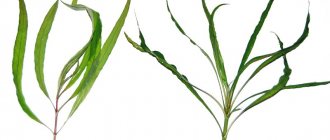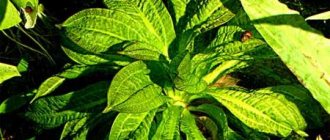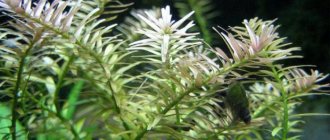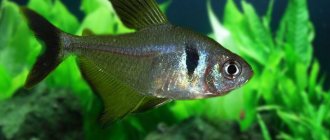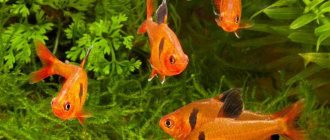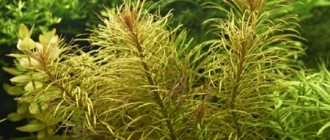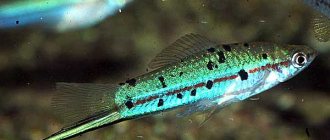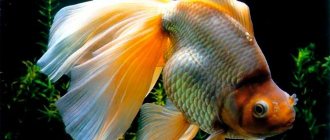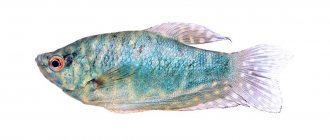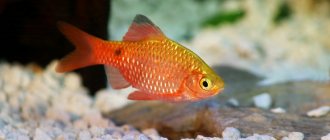The genus Salvínia has 12 species, most of which are distributed on the African continent.
| Domain (Regio) | Eukaryotes |
| Kingdom (Regnum) | Plants (Plantae) |
| Type (Phylum) (division) | Ferns or ferns (Polypodióphyta) |
| Class (Сlassis) | Ferns or true ferns (Polypodiópsida) |
| Squad (Ordo) (order) | Salviniales |
| Family | Salviniaceae |
| Genus | Salvinia |
- 4.1 Shadow
Botanical description and taxonomy
Salvínia is a free-floating perennial aquatic fern consisting of pairs of green to brown oval leaves connected by a horizontal stem.
— Advertising —
At the top of each leaf there are many tiny, hair-like structures that split and then join at the ends to form an egg-like structure. Underwater, each individual produces other leaves, which look like a small tuft of brown roots. The stems are thin and highly branched, up to 30 centimeters in length, from one to two millimeters in diameter. The length of leaf nodes varies inversely with fern density. Leaves grow in two types: submerged and floating. Immersed brown in color, deeply divided into a group of unbranched root-like filaments 2-25 centimeters long. The floating leaves are green, almost round, two-lobed, with a smooth edge. The upper surface is covered with rows of waxy, ovoid hairs one millimeter long.
Individuals have no roots. It is believed that the hair-like structures found on the submerged thread-like leaves are a replacement for the rhizome and help in the absorption of water and nutrients. These hairs differ from roots in that they are multicellular.
Reproduction and planting
Planting salvinia in an aquarium is very simple. There is no need to select soil for it. For it to take root, it is enough to rinse the selected bush and keep it in a separate container for some time. After such quarantine, it is transferred to a general aquarium and left on the surface. After a short period of adaptation, the plant will begin to actively grow and develop if there is enough iron and magnesium in the water and the lighting is bright enough.
But the growth rate must be carefully monitored, otherwise this floating aquarium plant can cover the entire surface of the aquarium and block the light for the rest of the flora, which will certainly lead to its death.
As for reproduction, as mentioned above, Salvinia Nathans does not produce seeds under artificial conditions. However, in an aquarium this method is not necessary. It is enough to monitor the development of the bush. It will begin to send out young lateral shoots. When they are formed, they can be safely separated. In addition, long bushes can simply be divided. The main thing is that it has one underwater and two surface sheets.
There are no other nuances of reproduction. It is only worth noting that salvinia is not planted next to pistia, since they will mutually impede growth. In addition, this fern should be thrown away from filters and currents. Firstly, it loves standing water, and secondly, broken parts can clog the equipment.
Primary habitat
— Advertising —
Salvínia grows best in still or slow-moving fresh water.
Salvinia plants also thrive in nutrient waters, such as waste water.
The botanical description indicates that the algae comes from southeastern Brazil. It has become an invasive species in Africa, India, Sri Lanka, Southeast Asia, the Philippines, Papua New Guinea, New Zealand, Fiji, Hawaii and parts of the United States.
Care
Salvinia is a very unpretentious representative of aquatic flora. It prefers to grow in warm water and good lighting, but in the absence of such, the bush will also grow in normal condition. To artificially maintain ferns, you need to select open aquariums. Indoor aquariums will have condensation on the lid. It can flow directly onto the leaves, which will negatively affect their health.
Water parameters
Salvinia is a heat-loving plant that loves warm water. The water temperature should not be less than 20°C and no more than 30°C. The bushes are not afraid of lower temperatures, but at the same time they begin to slow down their growth rate and may prevent spores from developing. Decorative features also suffer in the cold. In this case, the acidity and hardness of the fresh water poured into the aquarium must be taken into account. Acidity should be within 8, and hardness up to 15° dGH.
The water in the aquarium should be changed regularly. This must be done at least once every two weeks. In addition, it is necessary to constantly saturate the water in the container with oxygen. In addition, it is important to regularly replace a quarter of the water in the aquarium with clean, settled water.
Pruning and fertilizing
There is no need to constantly fertilize and feed salvinia. She receives all the substances necessary for her growth from water. Since the bush grows very quickly, it should be pruned regularly. In this case, the branching processes are removed. Only the central stem with leaves is left.
Lighting
Salvinia prefers a lot of light. In natural reservoirs it grows under the influence of regular sunlight. Therefore, when creating artificial conditions, it is important to create good lighting for the plant. It is especially important to maintain lighting during the breeding season of different species. This ensures faster sporulation and maturation of sporophytes in the sori.
To maintain the life of the plant in the aquarium, the fern should be illuminated for at least half a day every day. With insufficient light, the fern gradually withers and dies.
Plant species
Eared
— Advertising —
Salvinia auriculata or eared salvinia is a free-floating fern up to 20 centimeters long. The horizontal rhizome lies below the surface of the water. The leaves come in two types: floating and submerged, light green to gray-green in color, with brownish edges and a characteristic fold in the center. The floating leaves are oval-shaped, up to 2.5 centimeters long and 3.5 centimeters wide. The upper surface contains even rows of papillae, each with a tuft of hairs at the distal end, joined together at the ends into a shape similar to an egg corolla. The cellular structure of the terminal hairs gives the algae buoyancy.
Salvinia eared is widespread in ponds, pools and lakes throughout the Philippines and is native to South America.
The leaves contain proteins, nutrients, lignin, ash and tannins. Phytochemical screening showed the presence of alkaloids, flavonoids, phenols, tannins and saponins. The three main compounds of the leaflets are stigmasterone, stigmasterol and fridelinol.
Scientific research has proven the antimicrobial, phytoremediation (that is, the ability to purify water), biosorbent, and antioxidant properties of this fern.
Klobuchkovaya
Salvinia cucullata is a free-floating fern that develops from a somewhat zigzag horizontal stem (rhizome) that floats just below the surface of the water. The rhizome has opposite pairs of rectangular floating leaves and a third submerged filamentous leaf along each node. Almost all parts of Salvinia, with the exception of the upper surface of the leaf, are sparsely covered with chestnut-colored hairs. Country of origin: Southeast Asia.
floating
Salvinia natans, floating moss or fern, water butterfly are the names of this beautiful aquarium plant. This type of fern is excellent for providing shade over large areas of ponds. It provides both cover for small fish and a natural filter from sunlight.
Salvinia natans is a very recognizable species. Like a typical fern, it has feathery leaves that are arranged horizontally.
The leaves reach about 1.5 centimeters in length. At the base of the kelp grow two large leaves that lie on the surface of the water to keep the fern afloat. These leaves grow up to 2 centimeters in diameter. They are usually light green in color and have a protective layer called cuticular papillae.
The cuticular papillae are a unique layer of skin with hair follicles that prevent algae from rotting due to excessive exposure to water. This allows the algae to continue photosynthesizing while wet and also to withstand strong light.
The ability to tolerate direct sunlight is a rare feature of ferns. This makes Salvinia natans a popular choice for garden ponds and ponds.
Another distinctive aspect of Salvinia natans is its root structure. Instead of long, growing roots like most aquatic plants, it has just one leaf that points down into the water. Although, you can often see some root-like green threads hanging along the leaves. Not only is this a good way to identify moss, but it is also ideal for shallow ponds.
Description
Salvinia is a light green floating fern. It adapts very quickly and well to new conditions, due to which its growing area is quite wide. These are the reservoirs of Africa, the tropics of Asia, and the southern states of Europe. Sometimes it can be found on the territory of Russia, but closer to the resort regions, on the Volga, Kuban, and Don. That is, it can be found where the climate is warm enough. The further north a pond, stream or lake is, the less often this plant can be seen there.
What are the benefits for an aquarium?
Salvinia, as an aquarium plant, can bring quite a lot of benefits. Let's take a closer look.
Shadow
Adding Salvinia to your aquarium will provide shade for the fish as well as other plants located at the bottom of the aquarium in the substrate. Fish will definitely appreciate a little shade during the day from bright aquarium lights. The lower plants should also be slightly shaded, but care must be taken not to add too much of the species because the lower algae may suffer from lack of light.
Cleaning
The species provide a biological and chemical filtration process much like what your mechanical water filter does. Salvinia eat fish waste and then create good bacteria that helps keep the water clean and clear. Of course, this algae cannot be used as the only filtration process, but it will definitely help your filter last longer.
Protection
Fish like places where they can play and swim in schools. They may also sometimes need a place to hide and feel protected. This is especially true for small fish and fry.
Regardless of the reason, you will notice that your fish will appreciate the presence of the Salvinia genus and will continue to return to it.
Oxygen
Planting Salvinia in an aquarium is a great way to add oxygen to the water.
Plants operate on the principle of an aeration system, like ordinary vegetation in nature. This provides additional oxygen which will benefit the fish in the long run. High O2 levels in the aquarium also help control toxins.
Great view
Salvinias are very interesting and will add a great design touch to your aquarium, even though they don't have flowers. Their presence creates a very natural feeling of greenery and freshness.
The importance of the plant for the ecosystem
Some species are considered pests and weeds because they multiply very quickly, causing the ecosystem of water bodies to suffer. However, the fern gets along well in artificial reservoirs. With proper care, the plant brings great positive value to the aquarium ecosystem:
- the plant is a natural and reliable refuge for fish fry, and the surface leaves provide a good habitat for newts;
- Particles settle on the inside of the parts of the bush, which certain types of aquatic animals eat;
- Salvinia, when growing, creates a natural, beautiful surface that protects other inhabitants of the aquarium that do not like bright light;
- with the right approach to the development of salvinia, it will absorb nitrates from the aquarium. In addition, the plant improves the chemical composition of the water in the container by consuming excess elements.
Certain species of salvinia are protectors and saviors of the ecosystem of aquariums and ponds. However, uncontrolled reproduction of the bush causes negative consequences from the plant.
Reproduction methods
Popular question: does salvinia reproduce by spores or seeds? Salvinia reproduces using sporangia. Let's figure out what sporangium is. In the classical botanical sense, this is a special organ that produces spores in life forms such as plants, fungi and algae. In heterosporous species it produces microspores and is therefore called microsporangium; and when it produces macrospores it is called a megasporangium. Sporangia are united into sporocarps. Details of reproduction have been extensively studied in S. natans. Sporocarps appear in clusters ranging from 4 to 20. Sporocarps usually grow on the inner segments of submerged leaves. They are sympodial in location.
The shape of the sporocarp varies from spherical to ovoid, sometimes flattened and with ribbed surfaces. The sporocarp wall consists of two layers of cells. the young outer layer is covered with hairs.
The life cycle of salvinia, as a spore-bearing plant, is shown in the photo below.
Externally, all sporocarps are similar; they are monosporangiate. The first one or two sporocarps in each cluster are megasporangiate, while all subsequent ones formed are microsporangiate. The sporocarp at its base has a strong columnar rosette that carries a vascular supply to the sporocarp.
After the sporangia mature, the sporocarps detach from the leaves and sink to the bottom of the pond. In annual species, this usually occurs during September, when the plant breaks into pieces. Sporocarps open due to mechanical destruction of their walls. This results in the release of spores. In most cases, spores that float on the surface of the water are still surrounded by sporangial walls.
Position in taxonomy
Salvinia floating is included in the Salviniaceae family and the order of the same name (Salviniales). This order includes heterosporous aquatic and coastal aquatic ferns, distributed mainly in tropical areas.
Of interest are heterosporous aquatic ferns. An example is Salvinia floating, also belonging to the class of millipedes. This is a small floating plant in whose micro- and megasporangia micro- and megaspores mature. From microspores, highly reduced male gametophytes develop, consisting of two vegetative cells and two antheridia, each of which produces only 4 spermatozoa. The female gametophyte, located inside the megaspore, consists of several 40 cells filled with nutrients and 3-5 archegonia. When a sperm and egg fuse, a zygote is formed, giving rise to a diploid sporophyte. In general, the life cycle of Salvinia is similar to the development cycle of Selaginella.
The development cycles of gymnosperms represent a transitional stage between the development cycles of ferns and angiosperms. For example, pine produces two types of cones: small male cones, no more than 2.5 cm in length, and large female cones, reaching 45 cm in length in some species. The female cone consists of a number of scales, on the surface of each of which there are two ovules. Each ovule contains a diploid macrosporous mother cell. The latter divides meiotically, with the formation of four haploid macrospores, of which only one functions and develops into a multicellular macrogametophyte. Each such macrogametophyte has 2-3 female reproductive organs (archegonia), containing one large egg. On the underside of each scale of a male cone there are two microsporangia. These microsporangia contain a large number of microspore mother cells, each of which divides meiotically and forms four microspores. Located in the microsporangium, or pollen sac, the microspores undergo division and form a four-celled microgametophyte, or pollen grain. Free pollen is carried by the wind. Having reached the female cone, the pollen grain penetrates the ovule through a special opening - the micropyle - and comes into contact with the macrosporangium.
It may take more than a year before one of the pollen grain cells develops into a pollen tube, which grows through the macrosporangium and reaches the macrogametophyte. Another cell of the pollen grain divides, forming not a motile sperm, as in lower plants, but two male generative nuclei. When the end of the pollen tube reaches the neck of the archegonium and opens, two male nuclei emerge from it, which are located next to the egg. One of them fuses with the nucleus of the egg, forming a diploid zygote, and the other disappears. After fertilization, the zygote divides and differentiates to form a sporophyte embryo surrounded by tissues of the female gametophyte as well as tissues of the maternal sporophyte. This whole complex is a seed.
How to properly plant salvinia for aquarium keeping?
Salvinia is one of the easiest algae to grow. The best way to spread at home is to divide the existing mass into separate bunches. Place the bunches on the surface of the water and they will spread themselves quite quickly. Keep them in standing or slow-moving water and bright light to encourage growth. Once acclimated, trim and remove excess pieces.
Reproduction
Salvinia reproduces equally simply in two ways:
Disputes
During the process of sporulation, when in the fall the leaves with sori sink to the bottom for wintering, and in the spring the male and female gametophytes break through, emerge and, as a result of fertilization, form new plants.
Vegetatively
Vegetative propagation is available year-round. Its algorithm consists in awakening the nodal buds when separating a part of the plant from the mother stem.
Under natural conditions, a factor promoting the vegetative propagation of floating ferns can be the movement of birds or boats across the surface of a reservoir: as they move, they tear off fragments of the plant, creating the preconditions for the growth of new ones.
Plant care and maintenance rules
- The ideal environment to thrive is moist, well-lit, warm places. The water temperature is usually between 15 and 21 degrees Celsius.
- Most ferns prefer a more acidic environment, while Salvinia grows ideally in a neutral environment, the pH range being 6.5 and 7.5.
- Avoid any attempt to drown him underwater. Salvinia is a type of plant whose roots must be completely submerged and its leaves above the surface of the water.
- This species does not require feeding.
- Salvinia is accustomed to bright sunlight. From time to time this plant can be found in areas where shade is unavoidable. But for the most part, the floating fern likes to be in direct sunlight.
- Diseases and pests. Ways to deal with them.
Salvinia is generally not susceptible to diseases and pests.
But if the leaves of Salvinia turn pale, it means that it suffers from a lack of nutrients. You can use special fertilizers for aquatic plants.
| Sign | Element |
| The leaves are stunted, a yellow-green tint has appeared | Nitrogen |
| Leaves darken and curl | Phosphorus |
| Yellowness and brownishness of the tips of the leaves, the appearance of brown spots on the surface | Potassium |
| Yellowness and stunted growth of young leaves | Iron |
| There are whitish spots near the veins | Magnesium |
| Leaves and shoots turn black and die | Bor |
| Young leaves are curved and curl at the top | Calcium |
| Dark brown spots appear between the veins of young leaves | Manganese |
| Dying of soft tissues of leaves | Copper |
| Stopping or slowing down the growth of stems in thickness | Sulfur |
| Lime appears on the leaves | Carbon dioxide |
| Thick stems, late flowering | Nitrogen |
| Yellowing, appearance of necrotic spots on leaves and stems | Phosphorus |
| Clearing of leaves and internodes, growth retardation | Potassium |
| Darkening and curling of leaves | Magnesium |
| Interveinal chlorosis* of tissues, appearance of white necrotic spots | Calcium |
| Interveinal chlorosis of tissues, blanching of leaves | Iron |
| Yellowing and deformation of leaves | Bor |
| Chlorosis of lower leaves, appearance of brown spots | Copper |
| Formation of transparent areas on the veins | Zinc |
| The leaves become small and rough, later turning yellow | Chlorine |
Note: Chlorosis is a disease that occurs due to the inability of a plant to receive nutrients, which results in impaired chlorophyll formation and the ability to photosynthesize.
Salvinia floating in an aquarium
Salvinia floating is often cultivated as an aquarium plant.
Before placing in the aquarium, plants should be washed carefully, being careful not to break the stem and leaves. For additional insurance, it is useful to keep the salvinia for several days in a separate container filled with water from the aquarium.
It is permissible to divide a large plant into several parts, so that at least two leaves remain on each segment.
To grow salvinia floating, you need a moderately warm or tropical aquarium. In the aquarium, salvinia grows throughout the year, growing into a living green carpet. In summer, salvinia grows quickly. All that is required of the aquarist is to promptly remove excess overgrown ferns from the surface of the water.
The plant is not demanding in terms of growing conditions. The hardness and active reaction of the water do not matter much.
Salvinia floating
Salvinia floating grows well in both very soft and hard water.
Water that has an alkaline reaction can be detrimental to the plant. Therefore, when growing salvinia in a garden pond, you should avoid using limestone stones, especially crushed stone, which alkalizes the water.
The cover glass in the aquarium should be installed at an angle so that falling drops of condensation do not fall on the plant.
For good growth, the water temperature in the aquarium should not fall below 24°C, although the plant can grow quite satisfactorily in a temperature range of 20-28°C.
Lowering the water temperature will not destroy the plant, but it will slow down its growth and negatively affect its decorative properties. In cold water its leaves become smaller.
The lighting needs to be bright. The duration of daylight should be at least 12 hours. Salvinia feels better in sunlight, but if necessary, it is content with artificial light.
For artificial lighting, it is recommended to use fluorescent lamps or special phytolamps with a power of at least 3 W per 1 dm2 of area. It is not advisable to use incandescent lamps of equivalent power, as they dry out the air greatly. If burns appear on the leaves, this is due to the proximity of incandescent lamps. They need to be moved away, or better yet, replaced with fluorescent or phytolamps.
It is recommended to periodically feed salvinia with fertilizers containing microelements. Salvinia is a “live” indicator that allows you to judge the lack of microelements in water. In case of deficiency of magnesium and iron, the leaf blades of the plant turn yellow. If this happens, fertilizing should be done immediately.
A quarter of the water volume needs to be changed weekly.
Salvinia , taken from a natural reservoir, often dies by autumn, leaving only buds and spores, which overwinter and give birth to new young plants in the spring. Spores and buds must be kept separately at a low temperature (+ 5-10 ° C).
Salvinia floating propagates by stem shoots or spores. In an aquarium, the only method of reproduction is vegetative. A small piece with two leaves, separated from the main stem, will give rise to a new plant under favorable conditions.
Salvinia floating is practically not susceptible to diseases and is absolutely resistant to pests.
If the growth of salvinia slows down and the leaves become smaller, the reasons may lie in insufficient lighting, strong currents or a drop in temperature below the permissible +20°C. As a rule, after eliminating the cause that caused the growth problem, the plant quickly recovers.
Salvinia decorates an aquarium well, especially in low and wide tanks where the water surface is below the observer's eyes. The water surface, covered with a patterned green carpet, looks very impressive.
The beneficial properties of salvinia are not limited to this.
This fern plays an important role in maintaining a harmonious balance in the aquarium. Salvinia actively absorbs many harmful substances dissolved in water: ammonia and ammonium, phosphates, nitrites, cadmium, lead and heavy metals. This significantly improves and heals the aquatic environment. Therefore, the plant will be very appropriate in aquariums where fish and invertebrates are demanding on the composition of the water.
Salvinia perfectly coexists with aquatic mosses, in addition to the aesthetic combination, it also protects them from fouling.
And the underwater leaves of salvinia provide an excellent refuge for fry and small fish.
Underwater salvinia leaves provide an excellent refuge for fry and small fish
Salvinia floating is ideal for growing in a mini-pond. Small varietal nymphs, eichornia, pistia and other floating plants go well with it.
In the coastal zone, salvinia's can be sedge, low grasses, rush grasses and all kinds of flowering crops. Salvinia is often used to provide shade for other aquatic plants and animals that cannot tolerate bright sunlight.
Beneficial features
By the way, salvinia is almost alien to any diseases and is not afraid of pests. And it also performs many useful functions. But it happens that the plant reacts to a lack of iron and magnesium in the water. Because of this, it can develop chlorosis. The plant does not produce enough chlorophyll in the leaves, and over time they turn yellow.
Useful properties of salvinia:
- It is a decoration for an aquarium, especially if it grows in a low and wide tank, because it allows the observer to see the bottom as if covered with a bright green carpet.
Fish use salvinia as shelter - Maintains a harmonious balance of water in the aquarium. Salvinia will be very useful for aquarium inhabitants who require a particularly clean environment, because it purifies the water. This is a filter for ammonia, phosphates, cadmium and other heavy metals.
- Aquatic mosses do not grow as much in an aquarium containing ferns.
- Fish use this plant as shelter and hide there.
- Salvinia prevents the growth of harmful blue-green algae in aquariums or ponds.
This plant is ideal for pond conditions. Many floating plants are combined with it, for example, nymphea, pistia. In the coastal zone, sedge and rush plants combine well with the plant. Ferns are often spread in areas where it is necessary to create shade for aquatic animals and plants.
Fern content
It is best to place floating salvinia in moderately warm or tropical aquariums. The plant does not make any special demands on the conditions of its maintenance. For him, neither water hardness nor acidity matters - the fern grows equally well in both soft and hard water. The temperature in the aquarium should be maintained at a minimum of 24 degrees Celsius. If the water is heated to only 20 degrees, the growth of the plant will slow down (the leaves will become smaller), but will not stop completely.
If you have Salvinia floating in your aquarium, you should change the water regularly. It is recommended to use phytolamps with a power of three watts per liter and fluorescent lamps as artificial lighting devices for the tank. If you use incandescent lamps, make sure that their power is low, otherwise you can dry out the air.
Most popular types
The plant is widely used in aquarium farming. Its main valuable qualities are fast growth, unpretentiousness, and high decorative properties. Tropical species from America are grown in greenhouses and homes:
- Salvinia auricularis. She needs bright, good lighting and regular changes of water. A comfortable temperature for ferns is 20−30 degrees Celsius. But you need to remember that the warmer the water, the faster the plant increases in size. Its underwater leaves protect the inhabitants of the aquarium and serve as a spawning site for fish.
The main qualities of salvigna are fast growth and unpretentiousness. - Salvinia oblongifolia. This species reaches 10 cm in length, the leaves are opposite, paired, rectangular in shape. The color of the plant ranges from bright green to green with a red tint. Comfortable water temperature conditions are 20−28 degrees Celsius. If you keep such salvinia in cold water, its leaves will be very small. Grows best in high humidity and bright sunlight. Light leaves indicate a lack of microelements.
- In open bodies of water, the aquatic fern Salvinia floating best takes root. The first mention of it was made by the master of biology Carl Linnaeus in 1753. Its habitat is Africa and Asia, as well as the southern regions of Europe. It is noteworthy that this species is also found in some regions of Russia, such as the Volga, Don and Kuban basins. The extreme northern border of its growth is Belarus, where it is listed in the Red Book. This plant loves ponds with stagnant or slowly flowing water. Most often it can be found in oxbow lakes - drying up river beds.
But it is worth remembering that salvinia grows over large areas and can reach such a size that it covers the entire surface of the reservoir and prevents the entry of light, thereby having a detrimental effect on aquatic inhabitants.
Sometimes the entire surface of the water is covered with leaves and shoots of salvinia and in such areas oxygen saturation decreases, which negatively affects other inhabitants of the ecosystem and generally leads to worsening conditions for aquatic fauna and flora.
In some water bodies in Africa, the thickness of the vegetation cover reaches 20 cm , which makes it impossible for ships and schools of fish to pass through. Even hydroelectric power plants in such places cannot operate normally. And in the Congo, salvinia thickets sometimes completely block river channels, like a living dam.
https://youtube.com/watch?v=GxxqJT36oIg
